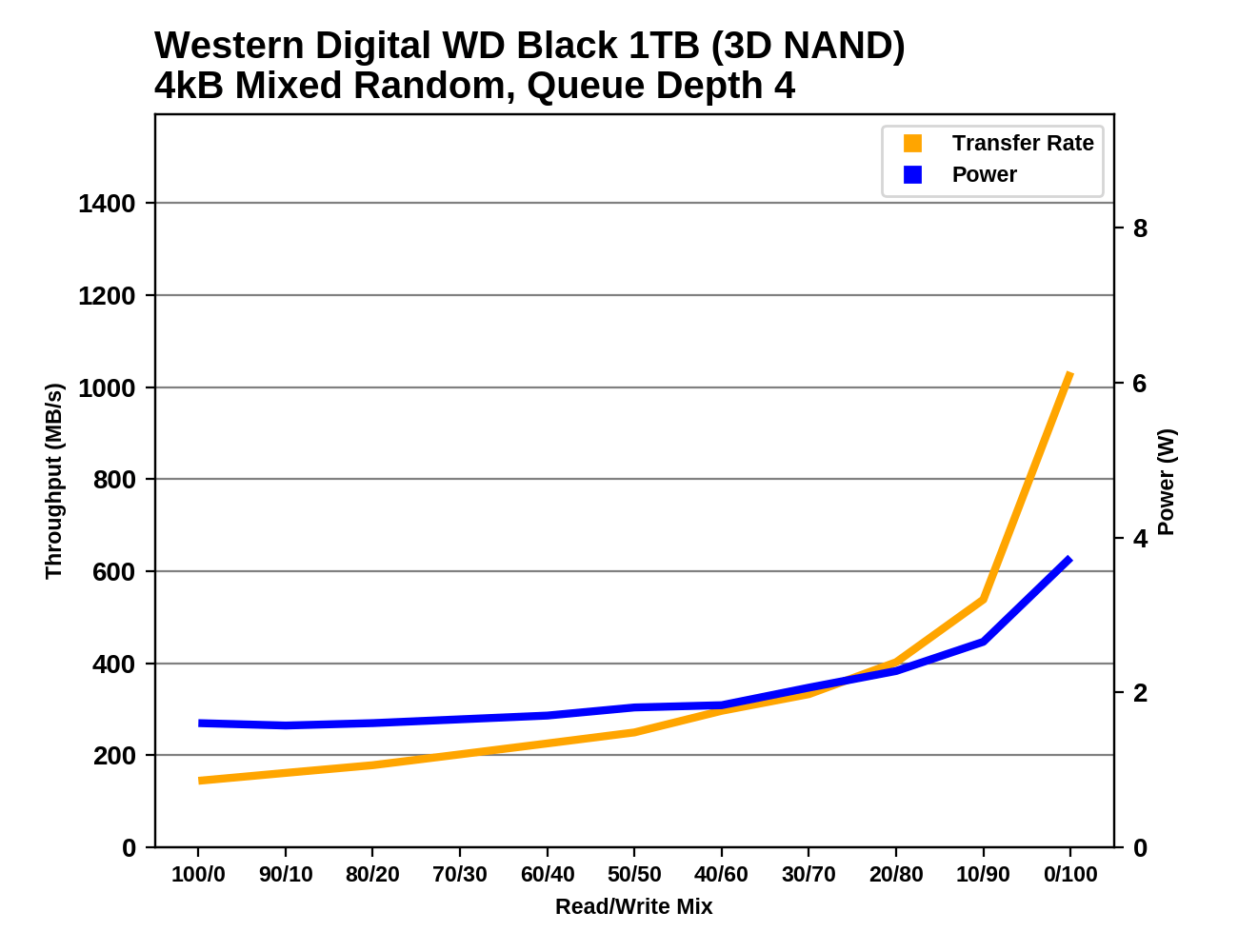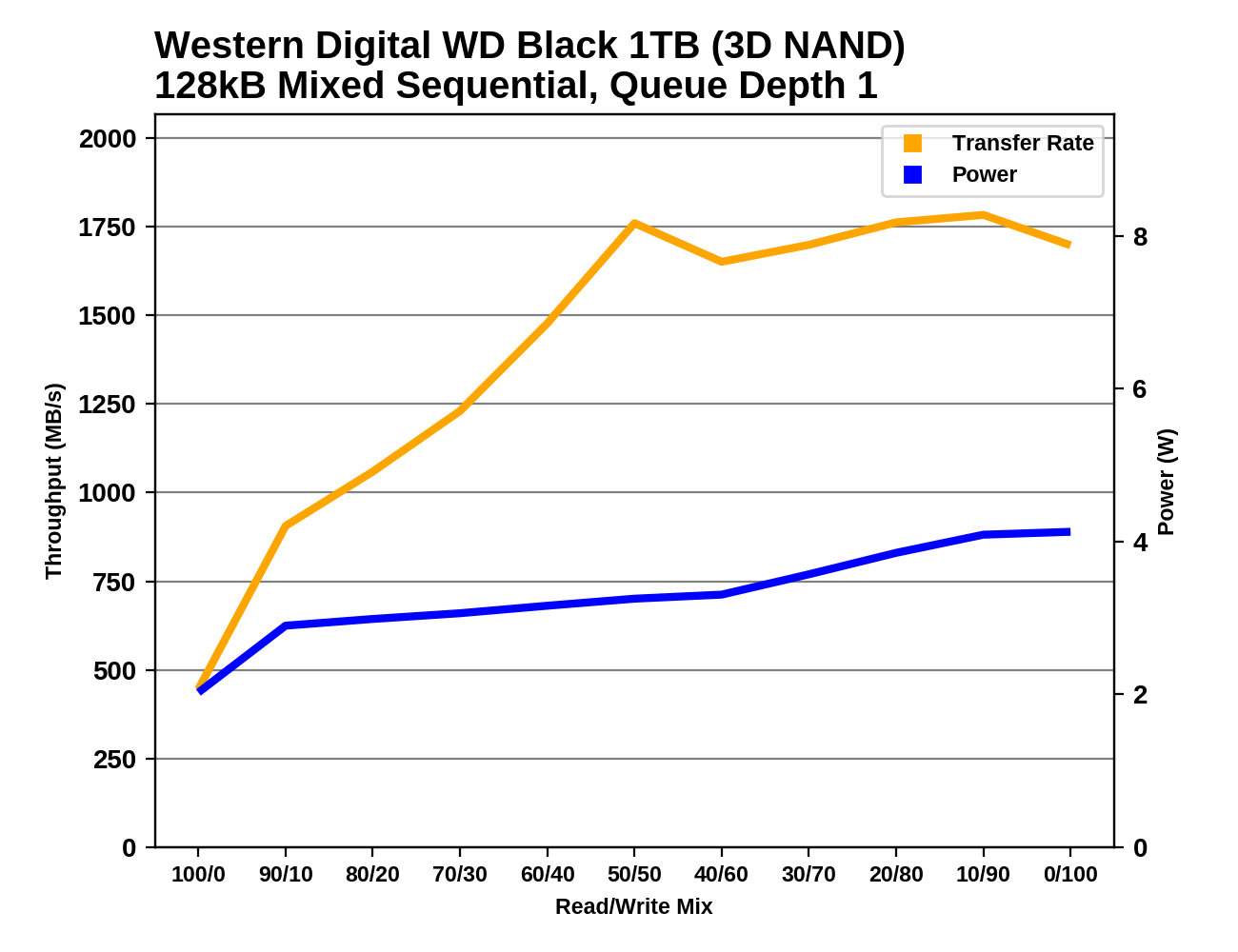The Western Digital WD Black 3D NAND SSD Review: EVO Meets Its Match
by Ganesh T S & Billy Tallis on April 5, 2018 9:45 AM EST- Posted in
- SSDs
- Storage
- Western Digital
- SanDisk
- NVMe
- Extreme Pro
- WD Black
Mixed Random Performance
Our test of mixed random reads and writes covers mixes varying from pure reads to pure writes at 10% increments. Each mix is tested for up to 1 minute or 32GB of data transferred. The test is conducted with a queue depth of 4, and is limited to a 64GB span of the drive. In between each mix, the drive is given idle time of up to one minute so that the overall duty cycle is 50%.

The WD Black offers great mixed random I/O performance, but it is still slightly slower overall than the best drives from Samsung, and the Optane SSD is in an entirely different league.
 |
|||||||||
| Power Efficiency in MB/s/W | Average Power in W | ||||||||
The WD Black's power efficiency on the mixed random I/O test is about the same as that of the Samsung 960 PRO, and close to the Optane SSD in spite of the vast difference in absolute performance level.
 |
|||||||||
The performance of the WD Black grows very slowly as the workload shifts from reads toward writes, but near the end of the test the good SLC write caching implementation gives the WD Black steep gains. Power consumption is under 2W for most of the test and doesn't quite reach 4W at the very end.
Mixed Sequential Performance
Our test of mixed sequential reads and writes differs from the mixed random I/O test by performing 128kB sequential accesses rather than 4kB accesses at random locations, and the sequential test is conducted at queue depth 1. The range of mixes tested is the same, and the timing and limits on data transfers are also the same as above.

The mixed sequential workload performance of the WD Black is surprisingly good, just barely behind the Optane SSD and far ahead of almost all flash-based SSDs.
 |
|||||||||
| Power Efficiency in MB/s/W | Average Power in W | ||||||||
The WD Black draws about the same power as other SSDs during the mixed sequential test, and combined with the great performance that translates to a huge lead in power efficiency.
 |
|||||||||
The performance scaling pattern of the WD Black on the mixed sequential test is quite unusual. Many drives show a bathtub curve with peak performance at either end of the test when the workload is pure reads or pure writes, and the worst performance in the middle of the test. By contrast, the WD Black starts out rather slowly but rapidly speeds up during the first half of the test, and stays near full performance for the entire second half.










69 Comments
View All Comments
FreckledTrout - Friday, April 6, 2018 - link
Since they like sticking to brands they have built like "Black" maybe these should be the new VelociRaptor series? When I here these I think black its 7,200 rpm and the Raptor is 10K rpm.tamalero - Friday, April 6, 2018 - link
They should have renamed the new BLACKs as PLATINUM or TITANIUM. It works.lilmoe - Thursday, April 5, 2018 - link
Ohhh?? Not bad! Still would've preferred if they had undercut Samsung on pricing a significant bit though.Samus - Thursday, April 5, 2018 - link
nCache 3.0's design has me concerned about write thrashing, which killed many Intel SSD's suffering from a bug causing write thrashing in just a few years. The Intel 2500's were chronically plagued with this bug because many OEM's (Lenovo...) never patched them and the drives burned themselves out doing tons of unnecessary house keeping.Hopefully nCache 3.0 has some failsafes.
imaheadcase - Friday, April 6, 2018 - link
It really blows my mind how companies are TERRIBLE at naming products. Its almost like they don't even use common sense for it. Granted these are marketed towards people who most likely are building own systems and what not...but even i'm confused with Intel branding even.At least name product lines based on something that stands out to people to remember.
If i'm not mistaken, isn't Western Digital Black also a platter hardrive as well? Put that into the fact that the article says some of the old versions still be on market even if different sizes..i can easily see someone ordering wrong part.
I miss the days when a CPU was sold based on clock speed alone.
I guess it doesn't help that Aandtech site ventured away from consumer based stuff to more industry based news/reviews.
Drazick - Friday, April 6, 2018 - link
I want this in U.2 or SATA Express format.KAlmquist - Friday, April 6, 2018 - link
At this point I wouldn't be inclined to recommend this drive. The performance reported in this review is good, but:1) It appears that Western Digital is only providing review samples of the 1TB model. For the smaller sizes, the only information we have about performance is the manufacturer's claims.
2) The peculiar branding. Two names for the same drive, both of which are the same as the names of older drives. In particular, a recommendation of the Black drive is likely to result in the person getting an older, slower drive.
3) The drive was just released so it has no track record.
JWKauffman - Friday, April 6, 2018 - link
I'm curious why WD apparently isn't supplying an NVMe driver to optimize their controller. I think the question should have been raised in the review.tamalero - Friday, April 6, 2018 - link
Most third party companies do not offer any kind of driver. They rely on Windows's.I have a Corsair MP500, same issue.
JWKauffman - Friday, April 6, 2018 - link
I understand that, but if I were WD and positioning these drives as Samsung competitors, I'd want to have a driver tailored to my controller the same as Samsung does.